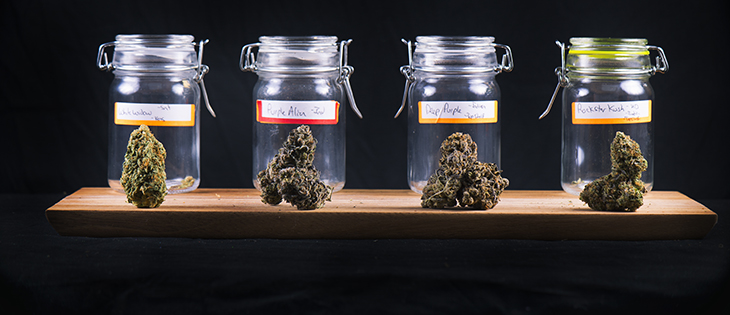Since the beginning of 2016, you could have practically thrown a dart at any marijuana stock and come out a winner far more times than not — and it’s not hard to understand why. The consumer pool for the legal cannabis industry is growing by leaps and bounds, with Canada becoming the first industrialized country to legalize adult-use pot in October, and two new states (Missouri and Utah) joining the previous 30 in giving the green light to medical weed. Residents in Michigan also voted in favor of becoming the 10th state to OK recreational marijuana.
The opportunity for the legal pot industry is huge. Investment firm Cowen Group, which has arguably been the biggest cannabis cheerleader on Wall Street, projects that aggregate annual sales could hit $75 billion by 2030. For added context, North American legal-channel marijuana sales in 2017 totaled “just” $9.7 billion, according to research firm ArcView. North America boasts what’s arguably the greatest sales growth opportunity for the marijuana industry, demonstrating just how much room is left for expansion in the years to come.
The big question has been, and continues to be: Where should you put your money to work?
Investors flock to pot dispensary stocks
The challenge with investing in marijuana stocks is that the U.S. market could easily be the most lucrative in the world. Yet, with the federal government holding firm on its Schedule I classification, the industry has a lot of red tape to work around. Meanwhile, Canada is legalized, but it will trail the U.S. significantly in peak sales potential.
For some folks, the most logical solution would be to consider an area of the U.S. cannabis industry that already appears to be thriving: vertically integrated marijuana dispensary stocks. By vertically integrated, I mean retailers that also operate growing and/or processing facilities, thereby controlling their supply chain of product.
There are three brand-name dispensaries that currently offer rapid growth potential in the U.S.: MedMen Enterprises (NASDAQOTH:MMNFF), Curaleaf Holdings (NASDAQOTH:LDVTF), and Trulieve Cannabis (NASDAQOTH:TCNNF). These three vertically integrated dispensary stocks account for a quarter of all the pure-play pot stocks that have a billion-dollar market cap right now.
Aside from their respectable size, the fact that these three pot dispensary stocks are seeing tangible sales growth clearly has investors excited.
These U.S. marijuana dispensary stocks offer rapid, tangible growth
MedMen is currently operating 14 stores in three states to go along with five cultivation sites. But the real excitement is its $682 million acquisition of privately held PharmaCann, which’ll double the number of states it has access to and add eight cultivation facilities and 18 retail licenses. During its latest fiscal year, MedMen recorded nearly $40 million in sales, representing a 1,390% increase from the prior-year period, with its sales-per-square-foot topping Apple stores. It’s probably the most well-known of the publicly traded cannabis dispensaries.
Curaleaf Holdings is the largest marijuana “IPO” in history, with the company (briefly) sporting a $4 billion-plus valuation when it debuted in late October. The company currently has 33 branded dispensaries spread through a dozen U.S. states. These 33 operating dispensaries make it the largest publicly traded chain-retailer of weed in the United States. Curaleaf has a dozen cultivation facilities and 10 processing sites, too. Sales have totaled $45.1 million through the first nine months of the year, which is more than triple the $13 million in revenue it had through the first nine months of 2017.
Finally, there’s Trulieve Cannabis, which just opened its 22nd dispensary in Florida. Earlier this month, the company also announced the acquisitions of Life Essence and Leef Industries, which are based in Massachusetts and California, respectively. This marks Trulieve’s first foray outside of Florida. During its third quarter, Trulieve recorded $28.3 million in sales, putting it on track to bring in over $100 million annually on an extrapolated basis.
But there’s one big problem
As more states push to legalize medical and recreational pot, it would, presumably, put MedMen, Curaleaf, and Trulieve in the driver’s seat. But there’s a glaring early-stage problem with this business model that investors might be overlooking: high expenses tied to store openings and acquisitions.
Whereas Canadian growers have very little revenue to speak of at the moment, dispensaries are generating quite a bit on an annual extrapolated basis. However, this sales growth is dependent on the opening of new retail locations. And since the interstate transport of cannabis isn’t allowed under federal law, it means that grow facilities and/or processing facilities may also need to be owned, constructed, and/or acquired in the states where these retailers choose to operate. It’s expensive to get into the retail cannabis business, and it’s unlikely to be a profitable venture on an operating basis for many of these stocks for quite some time.
In MedMen’s case, general and administrative expenses, which include its expansionary costs, soared to $98.2 million in fiscal 2018, up nearly 600% from the prior year. The costs to absorb PharmaCann, along with the expectation of tripling its store count by the end of 2020, could lead to operating losses of more than $100 million, in my opinion, in each of the next two years.
As for Curaleaf, it reported a $27.7 million gross profit through the first nine months of fiscal 2018, albeit $11 million of this was a fair-value adjustment for its biological assets (i.e., cannabis plants). Strip out this one-time benefit, and Curaleaf’s $16.7 million gross profit after costs of goods gets obliterated by $44.4 million in year-to-date operating expenses. Without its biological asset adjustment, Curaleaf would have lost $27.7 million through three quarters of the year.
Trulieve Cannabis is the lone exception. Even with its $24 million in net gain from fair-value adjustments on its biological assets stripped out, it would still have generated $28 million in income from operations after expenses. However, keep in mind that this is a company that, up to this point, has been operating in a single state (Florida). Once Trulieve moves beyond Florida’s borders, the costs to set up its new sales channels in California and Massachusetts will rise.
Supporting billion-dollar market caps for vertically integrated dispensaries that may struggle to turn an operating profit could prove difficult. That’s what makes dispensary stocks a group worth avoiding for the time being.
Credit: fool.com












